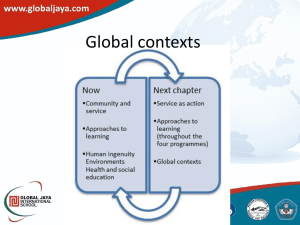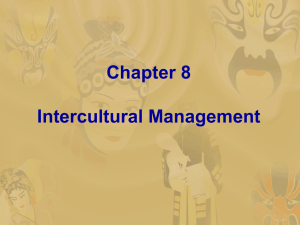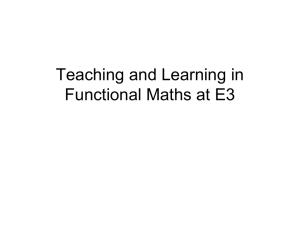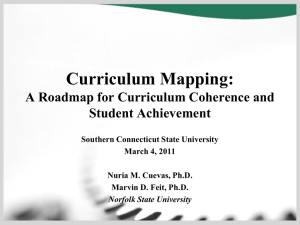Towards an anti-essentialist understanding of international education
advertisement
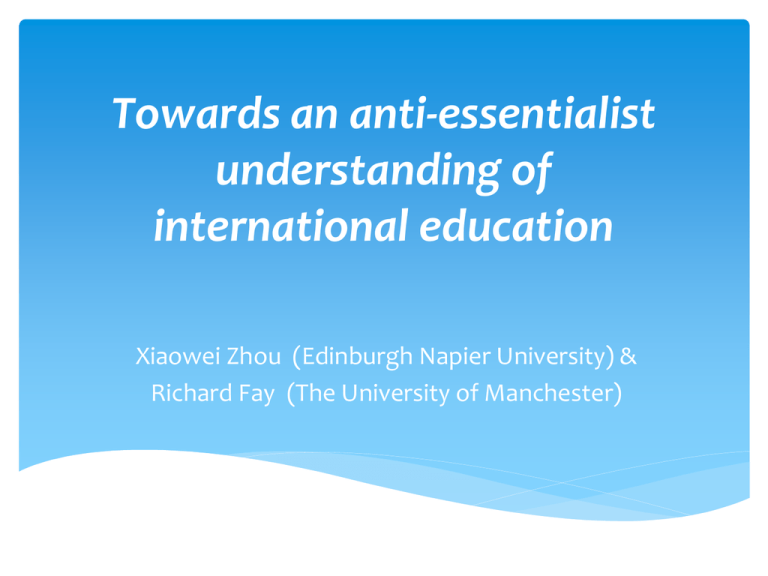
Towards an anti-essentialist understanding of international education Xiaowei Zhou (Edinburgh Napier University) & Richard Fay (The University of Manchester) Outline of the presentation Links to intercultural dialogue Introducing our teaching contexts One possible understanding of the contexts: the large-culture approach An alternative understanding of the contexts: the small-culture approach (Holliday, 1999; Singer, 1998) Conclusions Links to intercultural dialogue The complex culturality of educational contexts = a site for intercultural dialogue? “deeper understanding of diverse perspectives and practices” – developing understandings of the complex culturality of these educational contexts Xiaowei-Richard = collegial intercultural dialogue? Introducing our teaching contexts Xiaowei’s teaching context: … situated in a Business School … teaching “Intercultural Business Communication” (hereafter “IBC”) at both programme and modular levels … Masters students on the IBC module include: Belgium Business management Bulgaria International HRM China Croatia International Business management Afghanistan IBC Austria IBC with TESOL Czech International Marketing France Flexibly managed In terms of nationality … Or, in terms of programme of study … Introducing the contexts (continued …) Richard’s teaching context: situated across Schools of Education and Arts, Languages & Cultures [Humanities Faculty] MA TESOL, MA IC, PhDs [programmes] LEIP class – 17 nationalities with only 23 students MA IC seminar – American, German-Italian, Hong Kong Chinese, mainland Chinese, Thailand, ‘global nomad’ of Jamaican heritage [large culture characterisation] even the ‘British’ students are mostly ‘journeying’ TESOL-ers and IC-trainers Doctoral students – 4 from UK, + Canadian, Greek, Iceland, India, Indonesia, Swedish, Thai [large culture characterisation] -> lay understanding Our ‘insider’/ ‘outsider’ understandings of the teaching contexts shared desire to understand the complex culturality of our contexts decision to initially focus on the ‘Chinese student’ phenomenon … … by combining our specialised understandings: Xiaowei Richard • full ‘insider’ for P.R.China • full ‘insider’ for the UK • privileged ‘outsider’ for the UK • complete ‘outsider’ for P.R.China • relative ‘outsider’ to teaching in the UK • full ‘insider’ to teaching in the UK • full ‘insider’ as a student from P.R.China in the UK • full teaching ‘insider’ with students from P.R.China in the UK -> Literature One possible understanding of our teaching contexts: the large-culture approach Some insights from the literature about ‘Chinese students’ from a ‘Western’ point of view … ‘Chinese students’ are ‘passive recipients of knowledge’ and ‘quiet learners’ in the classroom; they ‘lack in critical or independent thinking’ (Ballard & Clanchy, 1991); They are ‘given to rote learning without developing real understandings’; they view knowledge as a reproduction of what they learn (Carson, 1992); ‘Chinese students’ are oriented to collective ways of thinking and think as the group thinks (Carson & Nelson, 1996); ‘CHC students’ believe that success is attributed more to personal effort than to innate ability (Biggs, 1996). One possible understanding of our teaching contexts: the large-culture approach (continued …) Some insights from the literature about ‘Western lecturers’ from a ‘Chinese’ point of view (Huang, 2005): the lecturers “did not logically organise their lectures”, while the students expect the lecturers to “make everything clear for them, including the difficult points and the important points”; the lecturers “do not feel constrained to follow the textbooks and the syllabuses”; the lecturers do not give clear definition of terms and concepta; and there is too much student participation in the classrooms, while the students are used to working individually in China. -> Large-culture understanding One possible understanding of complex teaching contexts: the large-culture approach ‘givens’ about (individuals from) Country A prescribe characteristics of collective communication ‘givens’ about (individuals from) Country B compare prescribe characteristics of collective communication Some reflections on the large-culture approach The large-culture approach seems to provide a convenient tool to make (often national-level) crosscultural comparisons. However, our approach, not strictly comparative, but still problematically large-culture in approach: US exploring (with our ‘insider’/ ‘outsider’ perspectives) relatively complex IT (the phenomenon of ‘Chinese’ students in the UK) simplistic -> Small-culture understanding An alternative understanding of our teaching contexts: the small-culture approach (Holliday, 1999) Possible cultural and contextual influences interpret Actual communication of an individual from Country A Possible cultural and contextual influences interpret Explore the interactional dynamic Actual communication of an individual from Country B An alternative understanding of our teaching contexts: the small-culture approach (continued …) National culture (including urban, village, regional and other activity cultures) Professional-academic cultures International educationrelated cultures Host institutional culture Classroom culture Student culture This figure is our reproduction of Holliday’s “host culture complex” (p.29, 1994). An alternative understanding of our teaching contexts: the small-culture approach (continued …) Lecturers In Uni B Lecturers in Uni A interculturalists’ community Richard Interculturalists’ community Xiaowei An alternative understanding of our teaching contexts: the small-culture approach (continued …) complex contextualised US IT complex complex An alternative understanding of our teaching contexts: The small-culture approach (continued …) Disciplinary culture: Intercultural Communication The culture of the UK HE Disciplinary culture: Business-related studies Xiaowei’s teaching context Other cultural influences … The lecturer’s expectations, experience and preferred teaching approach Host institutional culture: the Business School The culture of postgraduate education Students’ expectations and ways of learning brought from their previous academic contexts The HE cultures in the students’ home countries 15 15 An alternative understanding of our teaching contexts: The small-culture approach (continued …) Disciplinary culture: Intercultural Communication The culture of the UK HE Disciplinary culture: TESOL The lecturer’s expectations, experience and preferred teaching teachingapproach. Richard’s context Other cultural influences … The culture of postgraduate education The HE cultures in the students’ home countries Host institutional culture: School of Education Students’ expectations and ways of learning brought from their previous academic contexts -> Conclusions Concluding remarks Large-culture approach: Small-culture approach: • Prescriptive • Interpretive • Top-down • Bottom-up • Essentialist • Non-essentialist • Culturist (human thinking and • Operationalist (culture emerges through human interaction) behaviour is determined by culture) • Ruling out explanations other than explanations based on national/regional cultures • Open to all possible explanations, including explanations based on national/regional cultures Concluding remarks (continued …) Teaching context A Teaching context B We are working in contexts that are both similar and different, but not necessarily in national-level terms … Thank you! Xiaowei: leazxw113@hotmail.com Richard: frjfay@aol.com
